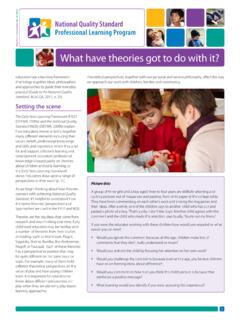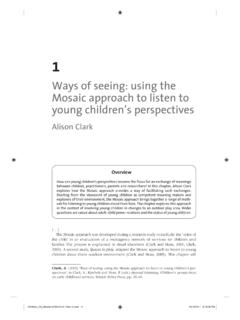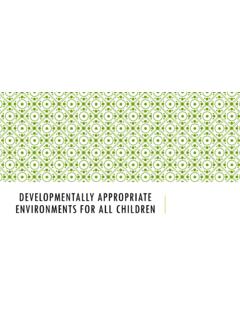Transcription of Science Concepts Young Children Learn Through Water Play
1 Dimensions of Early Childhood3 Vol 40, No 2, 2012 Science Concepts Young Children Learn Through Water PlayYoung Children can spend countless hours playing with Water : pouring it back and forth, watching it spill over the edge of a container, blocking its stream, directing its flow, splashing gently, making waves, and pouring some more. When a Water table is not available, they can often be found washing their hands in the bathroom for long periods of time, mesmerized by the Water . Sometimes it is hard for adults to encourage them to leave the sink. Few Children can resist Water s attraction. What is go-ing on here? Water is fascinating, fun, and multifaceted. Children can play with it endlessly.
2 But play, for play s sake, is not Water s only value (Crosser, 1994, Tovey, 1993). Indeed, Water play is a compelling focus of study for Young Children (Chalufour & Worth, 2005).The Concepts that Young Children Learn from Water play are essential for early childhood educators to be aware of and promote. As educational policymakers and adminis-trators push for more well-defined assessments of learning, teachers need to be able to clearly articulate the specific Concepts Children Learn during all types of play. This article identifies the Science Concepts involved in a variety of Water play activities and the teacher-mediated learning process that can accompany and enhance this Play/ Water StudyWater and a few inexpensive tools can provide a sen-sory and learning experience of immense proportions.
3 What is it Children get out of their Water study, which looks so much like fun? Free play with Water can build the foundation for understanding of a multitude of sci-entific Concepts , including those in physics (flow, motion), chemistry (solutions, cohesion), biology (plant and animal life), and mathematics (measurement, equivalence, volume).Mastery of these Concepts will support Children s understanding of academic subjects in later schooling and life. Science is indeed serious play (Wassermann, 1990). Science is everywhere around us. What can Children do to increase their understanding of Science ? Everything! (Wassermann, 1990, p. 107). Children in-quire, observe, compare, imagine, invent, design experi-ments, and theorize when they explore natural Science materials such as Water , sand, and mud.
4 Science Learning TheoryScience is a way of exploring and investigating the world around not only a way of knowing; it a way of doing (Wenham, 1995, p. 2). Science involves the discovery of factual knowledge (that something is true), causes for what is observed (why something oc-curs), and procedures (how something is investigated) (Wenham, 1995). Science education is a process of conceptual change in which Children reorganize their existing knowledge in order to understand Concepts and Carol M. GrossWhy is Water such a compelling source of learning pleasure for most Children ? This article convincingly identifies why Water play is a key Science and mathematics medium that enhances Young Children s learning Through Children can resist Water s of Early Childhood4 Vol 40, No 2, 2012completely (Havu-Nuutinen, 2005, p.)
5 259). The word process implies something that happens over time with repeated encounters. Children benefit the most from in-depth and long-term investigations (Gallas, 1995; Worth & Grollman (2003). Worth and Grollman give vivid, detailed accounts of possible trajectories that projects using the inquiry method can follow. They suggest an investigation of how and where puddles form. They describe an in-depth project about Water flow in a pre-K classroom that included creating whirlpools. Some of the Children then began to examine small drops of Water and how they behave on different surfaces, which led to exploring absorption, as National Science Educa-tion Standards (National Research Council, 1996) call for Science to be taught Through the inquiry method.
6 Inquiry follows the tradition of hands-on exploration of Children s own questions that eventually lead to discovery of scientific Concepts . Students should be actively in-volved in exploring phenomena that interest them. These investigations should be fun and open the door things to explore (Ameri-can Association for the Advancement of Science [AAAS], 1993, p. 10). Given these assertions and stan-dards, recurring Water play with varying tools and materials is cer-tainly a natural venue Through which to support beginning and ongoing Science learning. Play IS investiga-tion. Water is the source of life and, as such, can provide almost unlim-ited ExperiencesChildren s first learning experiences with Water , at home and in child care programs, usually include all kinds of pouring.
7 The tools need not be expensive and may even easily be found in the kitchen and recycle bin. Safe, unbreakable measuring cups and small containers (margarine tubs, yogurt cups) of different shapes and sizes alone can engage very Young Children . Sturdy funnels may come next. Ladles, straws, basters, and plastic droppers can be new experi-ences for Young Children who are old enough to know not to drink the Water . These tools are challenging to manipulate correctly so that they draw in and expel the Water . All kinds of sifters/colanders can be added, as well. Many Children use these simple Water -play experiences repeatedly to practice fine motor skills before they move on to more precise or complex activities with other tools.
8 How to Guide the Science Learning ProcessTeachers are researchers, designers, relationship orchestrators, listeners, observers, recorders, documenters of Children s work, collaborators, and mediators (Lewin-Benham, 2011). Expert early childhood teachers fa-cilitate Children s active involvement in the scientific process by provid-ing materials, encouraging Children to observe, predict, describe, and theorize about what they are doing. Teachers raise questions and prob-lems as Children play, helping them to grow in their thinking. This is an approach to learning that early childhood educators have Facilitate Children s active involvement in the scientific process by providing materi-als, encouraging Children to observe, predict, describe, and theorize about what they are doing.
9 Raise questions and problems as Children play, helping them to grow in their thinking. Subjects & PredicatesTools for Water ExplorationSmall, safe, unbreakable, sturdy, recycled when possible measuring cups containers of different shapes and sizes funnels ladles straws (when Children will not drink from them) basters droppers sifters colandersScience Concepts Young Children Learn Through Water PlayDimensions of Early Childhood5 Vol 40, No 2, 2012used historically, but has not always been recognized formally as promot-ing learning. It has been supported by many theorists, including Vy-gotsky (1978), Feuerstein (2011), Malaguzzi (1993), and many others. Learning happens in the relation-ships and conversations between novice and experienced learners.
10 Ex-perienced learners facilitate learning by asking questions and commenting as Children play (investigate). This approach has been used for decades in reggio Emilia schools in Italy, now world-renowned for their highly purposeful and in-depth approach to Young Children s learning. Lewin-Benham (2011) describes the teacher s role, integrating the reggio Emilia approach with what she refers to as other inspired approaches such as Montessori (1967), the Project approach (Katz & Chard, 2000), and the Creative Curriculum (Dodge, 2002): Create an open-flow schedule with flexible amounts of time for exploration Recognize that the environment is a teacher and determines the curriculum Engage Children in meaningful conversation Document Children s work and learning Assess Children s process and progressEngage in Meaningful Conversations At strategic moments, during play with Water and tools, teachers typically ask intentional questions to extend Children s thinking, expand their memory, and help use evidence to support their ideas.


